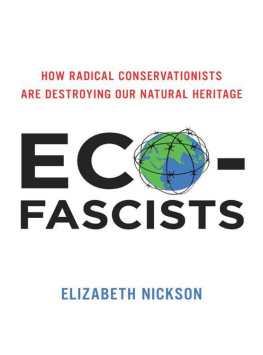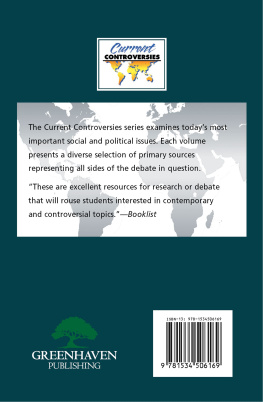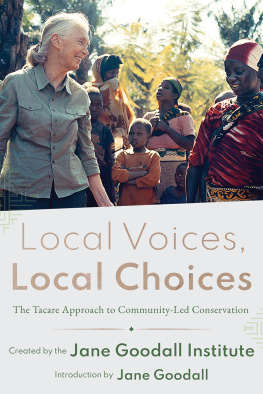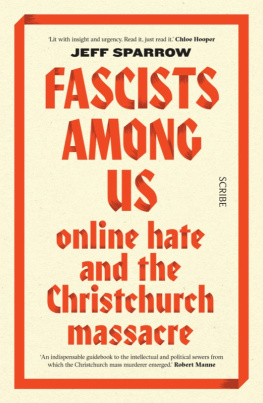ECO-FASCISTS
How Radical Conservationists
Are Destroying Our
Natural Heritage
Elizabeth Nickson

To Jamie and Virginia, who tether me to the earth
Contents
M ost criticism of the environmental movement, well founded or not, emanates like a cloud from economists and rationalists at think tanks who work principally with data and statistics. I am neither of those things, though I am very fond of numbers and reason.
By contrast, insofar as possible, I lived this book. In fact, I walk the green walk more than anyone Ive met. I live on sixteen acres of field and forest and creek. More than half of my landan older-growth forest and magnificent ravineis locked down in a perpetual no-touch covenant. I have a salmon enhancement project at the intersection of my two creeks. I am restoring two meadows. One used to be a gravel pit; the other, when I began work, was entirely covered by impenetrable Scotch broom, six feet high. Broom is an aggressive invasive shrub that has destroyed more indigenous plant life in my bioregion than any development, and its all I need for a gym for the rest of my life, because broom apparently never really dies.
I live in a green house heated by geothermal, and with the exception of the propane I use to cook, the house is carbon neutral, even though I think climate science is so corrupted that we have to go back to the beginning and start again. The house is structural rammed earth, which means its built out of dirt from the gravel pit a mile down the road, though the architecture owes more to Palladio than Middle Earth and I am a girl, so its a deep rose color. The house has enormous thermal mass, so it costs 50 percent less to heat than a conventional house of its size, and during winter power outages, it takes five days to lose its warmth. We have green roofs and an on-demand hot-water heater, among other green enhancements. The house has no drywall, no paints, no solvents, and could be certified as a healthy house.
Clearly I have integrated many of the dictates of the modern environment movement into my daily life. From this stance, from an open-hearted conformity to what I believe is a grand idea corrupted by powerful fanatics, I was able to understand the movements many disastrous failings.
I am also from an old country family, one of the founding families of the American republic, Puritan pioneers who arrived in 1630 praying and expounding the word of God the whole way, the Phelps clan hung on their cooking pot, cooked their homely meals and went down to the founding of Windsor in the Connecticut Valley in the 1650s. From there they spread, pioneering in every corner of the continent, bringing with them a hearty appetite for hard work and a hands-on local charity unrivaled today even by the standards of Mr. Gates; it was no small matter to be a businessman, community leader, and an officer of the Underground Railroad in the 1830s, 40s, and 50s, hiding fugitives in dugout cellars and tunnels under your house. Ideas inspired them; dozens fought in the revolutionary army, one was the spy at Fort Ticonderoga. Another, the initial county and township planner of the new republic in the 1780s, was deputy commissary of the revolutionary army. That coding lies in millions of us in the Americas, and it birthed the finest ideas the human race has ever developedideas that created staggering bounty and the greatest egalitarian nation the world has ever seen, ideas that have been replaced with an uncompromising and rigid bureaucratic command-and-control structure, which is creating yet another hybrid of the totalitarian state.
To say I was uninterested in my heritage before I began this book would be an overstatement, but as I grappled with the Leviathan we have created and the attendant research, I found myself sent back to their diaries and history again and again, for relief at first, then because the ideas were clear, beckoning to freedom, self-determination, and a comity that I frankly envied. Their ideas made sense; in contrast, what I was attempting to understand clutched at me like a wet, dark, extinguishing cloudso restrictive, punishing, and narrow that some days I was genuinely frightened. Some days, too, I felt my family reaching right through me, furious and despairing at what we are making. The principles that drove them through difficult and terrifying times began to propel me. As I peeled back each layer, I found myself growing implacably angry and opposed in a way I had never experienced.
I was trained as a reporter on the job at Time magazine, and in my seven years at the London bureau, Time Inc. sent me into disparate worlds, one after another. I went from deposed royalty to torture victims to grandees of every sort to Nelson Mandelas release, where I helped the company acquire his memoir. I learned, sink or swim, to get my bearings very quickly wherever I was and bring home the story. Reporters like me are notoriously hard to domesticate because they are habituated to the adrenaline of the chase, so the mounting horror I felt in every succeeding month was familiar stuff. Instead of spitting the lure out, I became further engaged.
The environmental movement has created a bewildering array of institutions that have been well hidden behind the scrim of modern life. Private foundations, the most pivotal in American culture, have been largely captured by a subset of grim zealots seeking to remake the world. They are joined by fervent true believers in federal and state agencies like the Department of the Interior, the Forest Service, the Environmental Protection Agency (EPA), the Fish and Wildlife Service, and a proliferation of others. These bureaucrats, if they miss a beat, are spurred, litigated against, and generally hagridden by nongovernmental organizations (NGOs), which marshal and mobilize tens of billions of dollars every year in the United States alone to promote their agenda. The complexity they have created is almost impossible to grasp in its entirety; it is a suffocating web of lies, distortions, fearmongering, and bad science married to top-of-the-line strategic planning, which has triggered an error cascade wreaking destruction everywhere prosecuted.
So what were the results, I asked myself, of this new green world? Were there any tough audits of the results? How were the ranges and forests faring under green command? What about the people? The next step became obvious. I jumped into my car and set out to meet the men and women who grapple with the beast daily, because otherwise their families would not eat. It was astounding to me that only one journalist in all of the United States, Timothy D. Findley, who died last year, had done systematic on-the-ground reporting of this story. While I didnt take his routes, I drove in his tracks, experiencing his bleary-eyed exhaustion as I pulled into the parking lot of a Best Western in a town of 3,452 somewhere on the ColoradoNew Mexico border at one in the morning.
I drove deep into Americas backcountry, through blinding snowstorms, over mountain passes, across black ice, and through torrential rains, all the way through Utah, Idaho, Wyoming, and Colorado twice, down to the Mexican border in California, and through New Mexicos boot heel to Texas. While those twelve or fifteen thousand miles should have been lonely and sometimes frightening, they were neither, not even along the most dangerous parts of the Mexican border. The country behind the strip malls and city access highways is so magnificent and the people so kind, funny, and warm, it was like driving through a lost paradise filled with newly met friends. If I were thirty, Id buy a string of cows and horses and vanish into Wyoming or Nevada or Idaho, never to be seen again.













